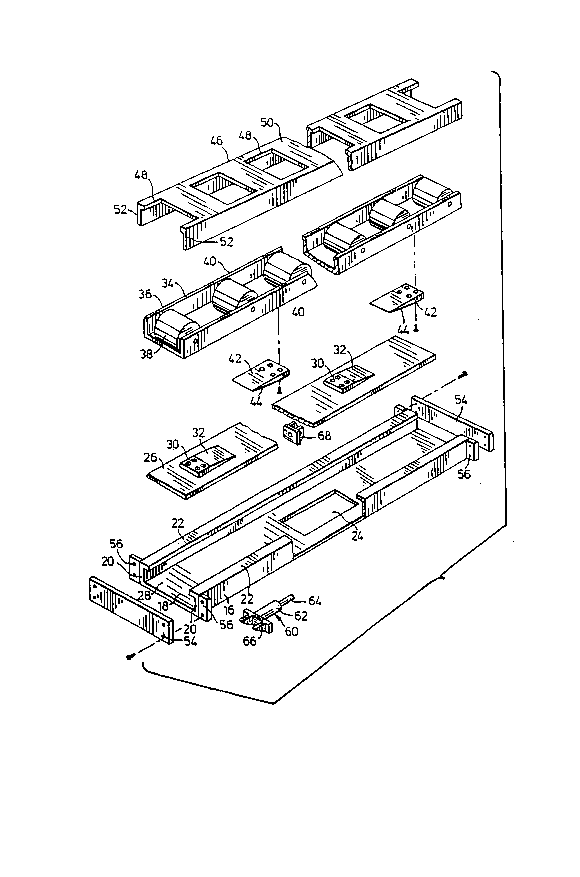Une partie des informations de ce site Web a été fournie par des sources externes. Le gouvernement du Canada n'assume aucune responsabilité concernant la précision, l'actualité ou la fiabilité des informations fournies par les sources externes. Les utilisateurs qui désirent employer cette information devraient consulter directement la source des informations. Le contenu fourni par les sources externes n'est pas assujetti aux exigences sur les langues officielles, la protection des renseignements personnels et l'accessibilité.
L'apparition de différences dans le texte et l'image des Revendications et de l'Abrégé dépend du moment auquel le document est publié. Les textes des Revendications et de l'Abrégé sont affichés :
| (12) Brevet: | (11) CA 2003548 |
|---|---|
| (54) Titre français: | RAIL A GALETS A MECANISME ELEVATEUR |
| (54) Titre anglais: | ROLLER TRACK ASSEMBLY INCORPORATING A MECHANICAL ELEVATOR MECHANISM |
| Statut: | Périmé et au-delà du délai pour l’annulation |
| (51) Classification internationale des brevets (CIB): |
|
|---|---|
| (72) Inventeurs : |
|
| (73) Titulaires : |
|
| (71) Demandeurs : |
|
| (74) Agent: | |
| (74) Co-agent: | |
| (45) Délivré: | 1993-04-27 |
| (22) Date de dépôt: | 1989-11-21 |
| (41) Mise à la disponibilité du public: | 1990-05-22 |
| Requête d'examen: | 1990-04-19 |
| Licence disponible: | S.O. |
| Cédé au domaine public: | S.O. |
| (25) Langue des documents déposés: | Anglais |
| Traité de coopération en matière de brevets (PCT): | Non |
|---|
| (30) Données de priorité de la demande: | ||||||
|---|---|---|---|---|---|---|
|
ABSTRACT
An elevating roller track assembly having a base member
and a lift bar located in a channel which is formed in the base
member. The lift bar is slidably mounted for longitudinal
movement relative to the base member. A first elevator ramp is
mounted on the lift bar. The first ramp has a first ramp face
which is inclined upwardly toward a first end of the base member.
A roller support member is slidably mounted in the base for
longitudinal movement. The roller support member has a bottom
wall overlying the lift bar. A plurality of load supporting
rollers are mounted for rotation on and extending upwardly from
the roller support member. A second elevator ramp is mounted on
the bottom wall of the roller support. The second elevator ramp
has a second ramp face which extends parallel to the first ramp
face in a face-to-face relationship therewith. A drive mechanism
is provided for driving the lift bar to and fro with respect to
the base member to cause the first and second ramp faces to slide
over one another to raise or lower the roller support member and
its associated rollers as required in use.
Note : Les revendications sont présentées dans la langue officielle dans laquelle elles ont été soumises.
Note : Les descriptions sont présentées dans la langue officielle dans laquelle elles ont été soumises.

2024-08-01 : Dans le cadre de la transition vers les Brevets de nouvelle génération (BNG), la base de données sur les brevets canadiens (BDBC) contient désormais un Historique d'événement plus détaillé, qui reproduit le Journal des événements de notre nouvelle solution interne.
Veuillez noter que les événements débutant par « Inactive : » se réfèrent à des événements qui ne sont plus utilisés dans notre nouvelle solution interne.
Pour une meilleure compréhension de l'état de la demande ou brevet qui figure sur cette page, la rubrique Mise en garde , et les descriptions de Brevet , Historique d'événement , Taxes périodiques et Historique des paiements devraient être consultées.
| Description | Date |
|---|---|
| Inactive : CIB de MCD | 2006-03-11 |
| Le délai pour l'annulation est expiré | 1999-11-22 |
| Inactive : Demande ad hoc documentée | 1999-10-01 |
| Lettre envoyée | 1998-11-23 |
| Accordé par délivrance | 1993-04-27 |
| Demande publiée (accessible au public) | 1990-05-22 |
| Toutes les exigences pour l'examen - jugée conforme | 1990-04-19 |
| Exigences pour une requête d'examen - jugée conforme | 1990-04-19 |
Il n'y a pas d'historique d'abandonnement
| Type de taxes | Anniversaire | Échéance | Date payée |
|---|---|---|---|
| TM (brevet, 8e anniv.) - générale | 1997-11-21 | 1997-09-19 |
Les titulaires actuels et antérieures au dossier sont affichés en ordre alphabétique.
| Titulaires actuels au dossier |
|---|
| ROBERT J. THORNDYKE |
| Titulaires antérieures au dossier |
|---|
| ROBERT JOHN THORNDYKE |